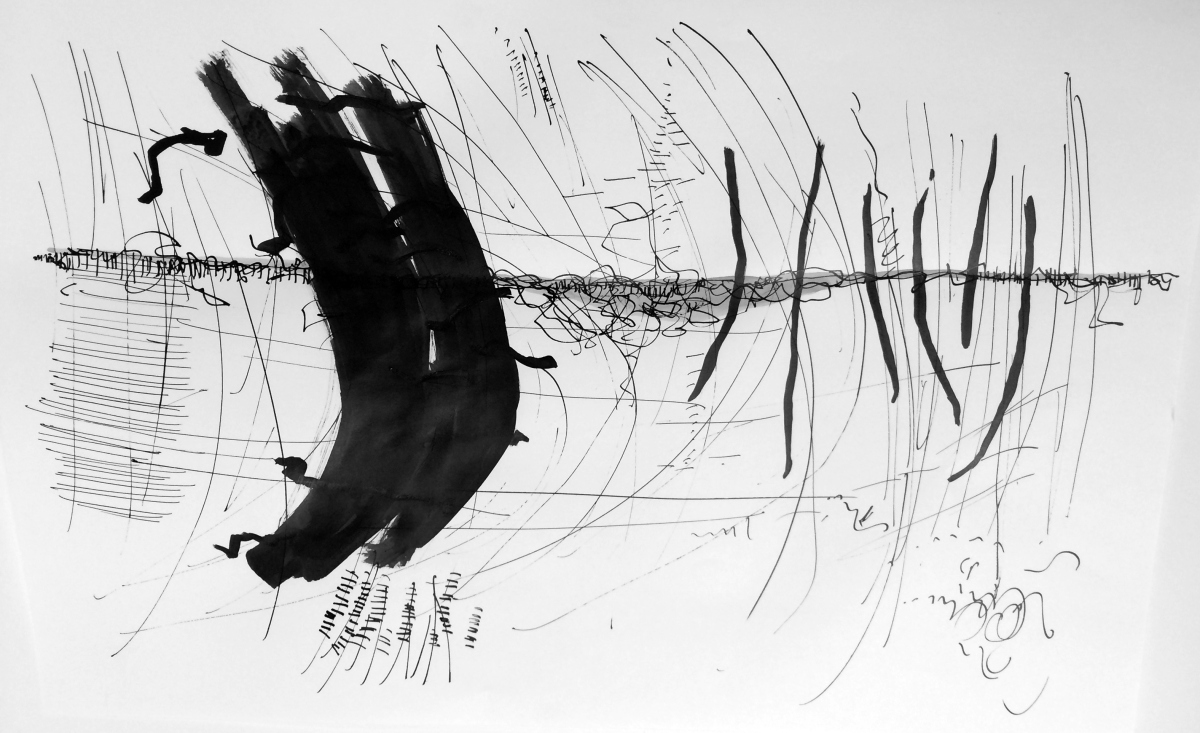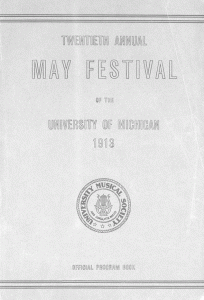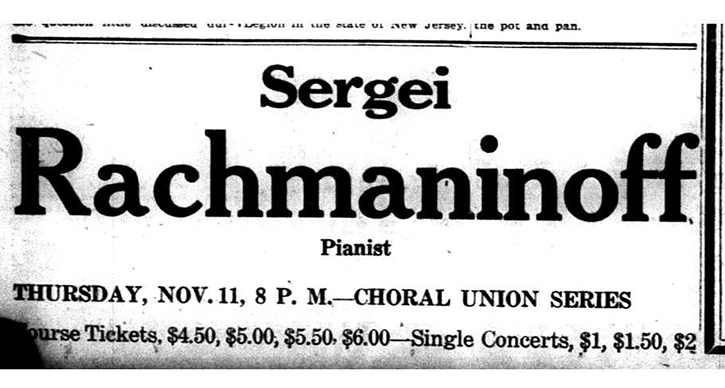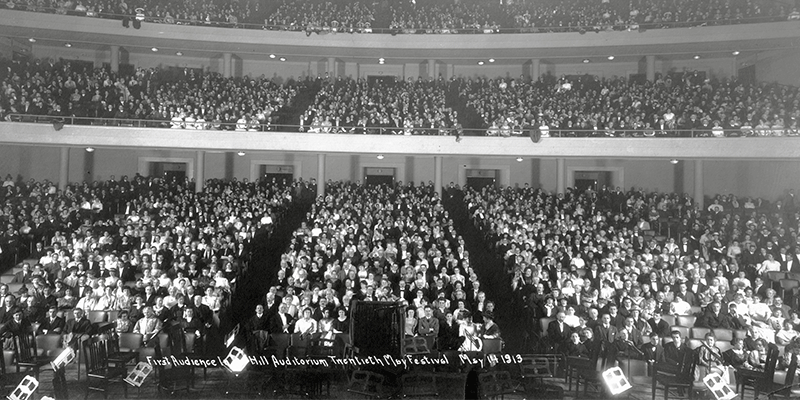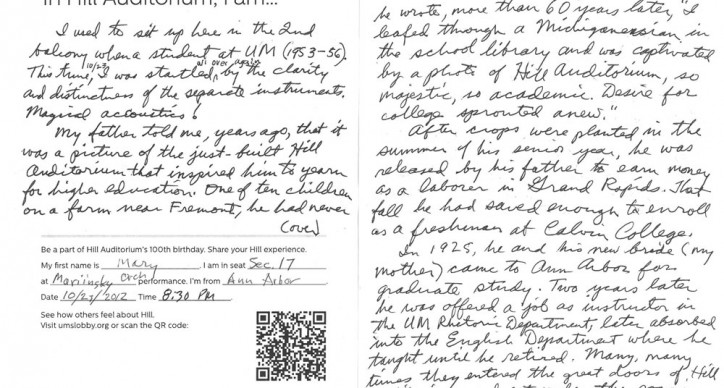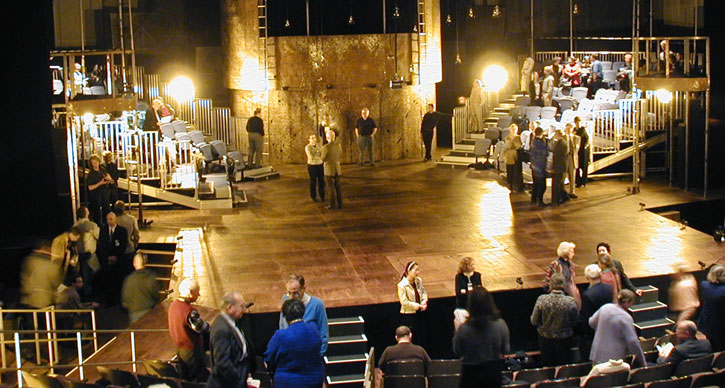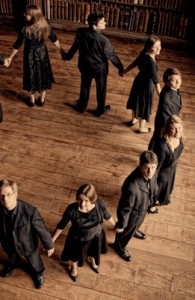Resident Update: Writer Robert James Russell
Writer Robert James Russell is a UMS Artist in Residence this season. We’ve asked five artists from across disciplines to take “residence” at our performances and to share the work these performances inspire. Robert shares his experiences on dance, music, and his new novel below:
“When I applied for the UMS Artists-in-Residency program, my goal was to see performances and use that inspiration to craft a new novel. I’m beyond thrilled at the chance to experience wonderful performances and explore the role of music and dance in my work—both of which have always been crucial to my mental health, and to my ability to immerse myself in a project.
So far, I’ve seen the following UMS performances, all radically different from one another—and each has inspired me in vastly different ways:
- Ryoji Ikeda (superposition)
- Mariinsky Orchestra
- Compagnie Marie Chouinard
- eighth blackbird
See, this isn’t just writing a novel, coming up with a story and characters, but in this instance I am creating an entirely new place: a fictional island in Lake Superior, documenting the entire history of the island, of the people that lived (and, in the present of my novel, still live) there. Typically when I write I find some style of music that works for that story and I listen to the same record(s) over and over as I write, never growing tire of the repetition. In this instance, though, since it’s not just story, but history…and this immersion in different types of performances has been utterly liberating:
- superposition taught me, even through the wondrous noise, about the use of silence in my work.
- The Mariinsky Orchestra inspired me to embrace more bombastic/dramatic sections of the story.
- Watching the Compagnie Marie Chouinard showed me how to re-think interactions of characters, how they meet in the story, but also how these characters interact with the island itself.
- eighth blackbird encouraged me to embrace the unexpected—to travel different routes in the storytelling, in the creation of the island’s history, of its inhabitants, and to avoid the predictable…to really dig deep and do something unique.
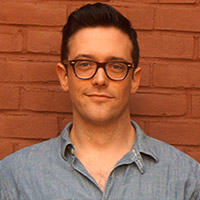 Each of these performances has taught me re-think what I know about art and inspiration, and they are with me every day when I write. In addition to a seemingly never-ending list of books I flip through daily—various back-issues of National Geographic featuring articles about Isle Royale (used as inspiration); a 1937 manual called Wolf and Coyote Trapping; the unbelievably inspiring/gorgeous Atlas of Remote Islands by Judith Schalansky; others—I am constantly harkening back to each performance, remembering them, and making sure that they are not forgotten. And I am reminded with every word I put down how astonishing and remarkable the performing arts are…how important they are to the production of any art.”
Each of these performances has taught me re-think what I know about art and inspiration, and they are with me every day when I write. In addition to a seemingly never-ending list of books I flip through daily—various back-issues of National Geographic featuring articles about Isle Royale (used as inspiration); a 1937 manual called Wolf and Coyote Trapping; the unbelievably inspiring/gorgeous Atlas of Remote Islands by Judith Schalansky; others—I am constantly harkening back to each performance, remembering them, and making sure that they are not forgotten. And I am reminded with every word I put down how astonishing and remarkable the performing arts are…how important they are to the production of any art.”
——
Robert James Russell is the author of two upcoming books: the collection Don’t Ask Me to Spell It Out (WhiskeyPaper Press, 2015) and the novel Mesilla (Dock Street Press, 2015). His first novel, Sea of Trees, was published in 2012. He is the founding editor of the literary journals Midwestern Gothic and CHEAP POP. You can find him online at robertjamesrussell.com and @robhollywood.”
Interested in learning more? Read our interview with Robert.
Resident Update: Painter Carolyn Reed Barritt on Compagnie Marie Chouinard + Mariinsky Orchestra
Painter Carolyn Reed Barritt is a UMS Artist in Residence this season. We’ve asked five artists from across disciplines to take “residence” at our performances and to share the work these performances inspire.
Carolyn attended Compagnie Marie Chouinard on January 23rd, and Mariinsky Orchestra on January 25th, 2015. She shares her thoughts on both performances:
“M
arie Chouinard’s Gymnopedies begins languidly, with the dancers emerging nymph-like and naked from canvas pods, then morphs into a seemingly non-stop riot of movement and role playing that was sometimes so sexy it was almost uncomfortable and sometimes so childishly silly that the audience didn’t quite know whether or not to laugh. The Henri Michaux piece brought movement up to another hyper level and was reminiscent of a dance contest gone too far. The dancers, mimicking the projected ink blots of Michaux’s Mouvements, expressed the drawings in broken, jagged lines, with an awkward jerkiness that was softened with a fluid, serpentine beauty.”
On Mariinksy:
“Before entering the hall for Mariinsky, I was given a flyer by a person protesting the orchestra. Last weekend I read the New York Times’ interview with Gergiev. I know a little about the situation in Ukraine, but don’t know as much as I should. Reading neither the flyer or the Times interview really enlightened me as to Gergiev’s personal views or the views of anyone in the orchestra. But what I have heard and read about Ukraine was in my mind at the concert and I’m sure it tainted my experience that afternoon.”
Read the full post on Carolyn’s blog
Interested in learning more? Read our interview with Carolyn.
This Day in UMS: Twentieth Annual UMS May Festival
Editor’s Note: “This day in UMS History” is an occasional series of vignettes drawn from UMS’s historical archive. If you have a personal story or particular memory from attending the performance featured here, we’d love to hear from you in the comments.
May 14-17, 1913: Twentieth Annual UMS May Festival
Featuring five concerts over five evenings, the Chicago Symphony Orchestra, UMS Choral Union, and the Children’s Choir were featured on the Twentieth Annual May Festival, the opening series of concerts at Hill Auditorium. The opening concert featured works by Wagner, Beethoven, A.A. Stanley, and Brahms.
Hill Auditorium celebrated its one hundredth birthday on May 14, 2013. If you’d like to learn more about our history with the storied venue, watch our documentary A Space for Music, A Seat for Everyone.
Interviews with Uncommon Virtuosos: Robert Alexander
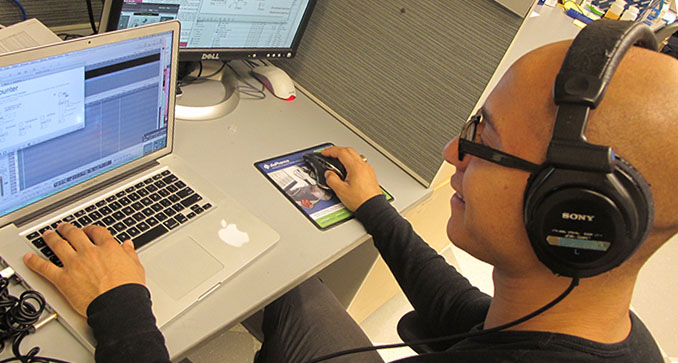
Photo: Robert Alexander. Photo by Kärt Tomberg.
Robert Alexander is a sonification specialist working with the Solar and Heliospheric Research Group at the University of Michigan, where he is pursuing a PhD in Design Science. He is also collaborating with scientists at NASA Goddard, and using sonification to investigate the sun and the solar winds.
We met Robert this fall and got to talking about “uncommon virtuosos” – those who master an instrument or genre in unexpected ways, whether Colin Stetson on the baritone saxophone this January or Chris Thile on the mandolin last October.
We sat down with Robert to talk to him about the nuts and bolts of sonification, his new work in sonifying solar wind and DNA, and whether he’d consider the sounds of the sun improvisation.
Nisreen Salka: How did you get into sonification?
Robert Alexander: My background is in music composition and interface design as the focus of my undergraduate and master’s studies, and I transitioned more into using those disciplines towards scientific investigations more recently. I came to work with sonification specifically when I was approached by Thomas Zurbuchen, who is the leader of Solar Heliospheric Research Group (SHRG), and they had this crazy idea of hey, let’s take our data, turn it into sound, and see if we can learn anything new.
NS: Could you describe sonification for the laymen among us? How does that relate to your previous experience in music composition?
RA: Sonification is the use of non-speech audio to convey information. And the idea is that rather than visualizing data and creating a graph or something of that nature, we can instead create an auditory graph. So if we have something like a data value that’s constantly rising, rather than displaying that as a line that constantly goes up, we can have a sound that constantly goes up in pitch.
NS: In your mini documentary about the project with Solar and Heliospheric Research Group (SHRG), you talk about including a drum beat and an alto voice to better personify the satellite data. How did you figure out which musical elements would work?
RA: Well, it’s a process where I first begin by getting as close to the data and the underlying science as possible because I want to let the data to speak for itself, and try to find the natural voice of the data. Once I get a sense for what the data are actually saying and what the data parameters are actually telling me, then I can start to think a little bit about, okay, how could this unfold musically?
And that’s largely a process of trying to work with informed intuition. I’m trying to think about what sort of knowledge the listener is going to bring to the listening process, and I try to work with sounds that might be intuitive.
NS: Sonification seems like a medium for improvisation, but there’s a lot of structural overlay. Do you, as a composer, consider your work improvisational?
RA: I think there’s very much an improvisational element, and you’re going to find that in scientific research even though you may expect it less. We’re talking about an interaction in which we feel so connected with our instruments that we are able to go from an idea to an expression of that idea in a very short amount of time. And one of my goals has been to take this kind of immediacy and try to infuse the sciences with that immediate feedback.
NS: It sounds like sonification really a combination of two disciplines. How did this fusion happen for you? What about this process attracts you both as a scientist and an artist?
RA: As a composer, I’ve always used music to explore my own psyche and the human condition as a form of self-expression. I think the largest shift that took place in my thinking as a composer was this kind of shift from thinking about music and asking, “What do I want to express?” to instead thinking, “How could I use these compositional tools to allow something like the sun to express itself?” I saw this as an opportunity to take something I really love and channel that through a rich learning process.
When science or music happen at a very high level, they are both infused with creativity. And I think the idea of that separation between art and science is more of a modern invention. When I think about these two disciplines, I tend to think about the things that bring them together. A lot of science has sprung forward through different types of intuitive leaps, and I think that it’s this place of intuition that plays into the process of being a creative professional or of being a scientific researcher. That’s the core of a lot of the work that I do.
NS: How do you think people receive what you do? What is their perception when they see the final result?
RA: I think many people initially think, well that is “cool.” But for me, the question isn’t, “How do we make something cool?” The question is “How do we learn something new?” In the moment when we are able to uncover something in a data set with our ears, it’s still cool. But to actually learn something, then it also becomes powerful.
In all of my work, I try to pair the music and the data such that I’m providing knowledge as to how the musical form is drawn directly from the underlying data set. I like to encourage the listener then to simultaneously absorb the music and to investigate the underlying science because that’s when sonification really becomes powerful, when it can fuel the learning process. It takes the abstract and the esoteric and makes it more approachable.
NS: We know that one of your newer projects is the sonification of DNA. How does that relate to your previous work? What about it is new and what about it is similar to what you have done in the past?
RA: This project was an opportunity to take everything I have learned in the space sciences and to apply that to a new discipline in which I had limited prior knowledge. Just like working with solar wind data, we were working with incredibly large amounts of information. Millions of data points could potentially be passing by the ear over the course of a minute.
We were successful in creating an auditory translation, where you can hear where the transcription process starts and ends, and you can hear the structure of the gene. It was really fascinating to have a sense for how this would unfold temporally rather than just seeing it as a sequence of numbers or letters.
A lot of genetic research has also utilized spectral analysis to analyze repeated elements in DNA. And turns out if we take that raw data and turn it into sound, we can hear those repeated elements. Sonification could potentially allow us to hear some of the subtle details in these structures.
NS: Is there anything else we haven’t covered that you want to add about your projects?
RA: There are still a lot of mysteries when it comes to solar science. And we are looking at sonification as a way to gain new insights. Working at NASA Goddard alongside several research scientists there, we actually uncovered quite a variety of new features with our ears that we’re now investigating through traditional research methods.
And so for me, it’s a really exciting time. We came into the project wondering if we’d find something new, and now we’re at the point where I can say that we have been successful in uncovering new science through the process of data sonification, and we’re continuing to discover new things.
Learn more about Robert’s work here. Questions or thoughts? Leave them in the comments below.
This Day in UMS: Sergei Rachmaninoff
Editor’s Note: “This day in UMS History” is an occasional series of vignettes drawn from UMS’s historical archive. If you have a personal story or particular memory from attending the performance featured here, we’d love to hear from you in the comments.
November 11, 1920: Sergei Rachmaninoff in UMS Choral Union Series
Photo: Advertisement in the Ann Arbor News (Ann Arbor News Ann Archives, Arbor District Library).
The celebrated Russian pianist and composer Sergei Rachmaninoff performed solo in Hill Auditorium as part of the 42nd season of the Choral Union Series on November 11, 1920. He opened his recital with a performance of “The Star Spangled Banner,” during which the entire audience remained sanding. The remainder of his program consisted of six pieces: Beethoven’s Sonate Opus 90 in e minor, Mendelssohn’s Six Songs Without Words, Chopin’s Ballade, Valse, and Barcarolle, Grieg’s On the Mountains, Liszt’s Rhapsodie Espagnol, and his own Prelude, C-sharp minor Etude-Tableaux, Opus 33.
His masterful tone, unique personality, and flawless technique delighted a sold out Hill Auditorium, as audience members were in awe of his interpretation of his own works and how he portrayed the sorrow and fatalism of his own Russia. Sergei Rachmaninoff returned to Ann Arbor and Hill Auditorium for a second time in 1939, performing another solo recital as part of the 61st Choral Union Series.
This Day in UMS: Enrico Caruso
Editor’s Note: “This day in UMS History” is an occasional series of vignettes drawn from UMS’s historical archive. If you have a personal story or particular memory from attending the performance featured here, we’d love to hear from you in the comments.
October 19, 1918: Enrico Caruso with Nina Morgana, soprano, and Elias Breeskin, violinist
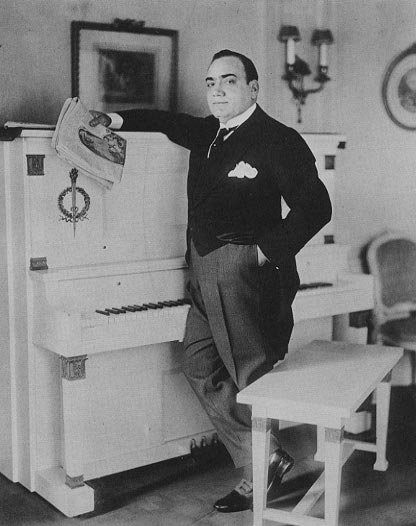
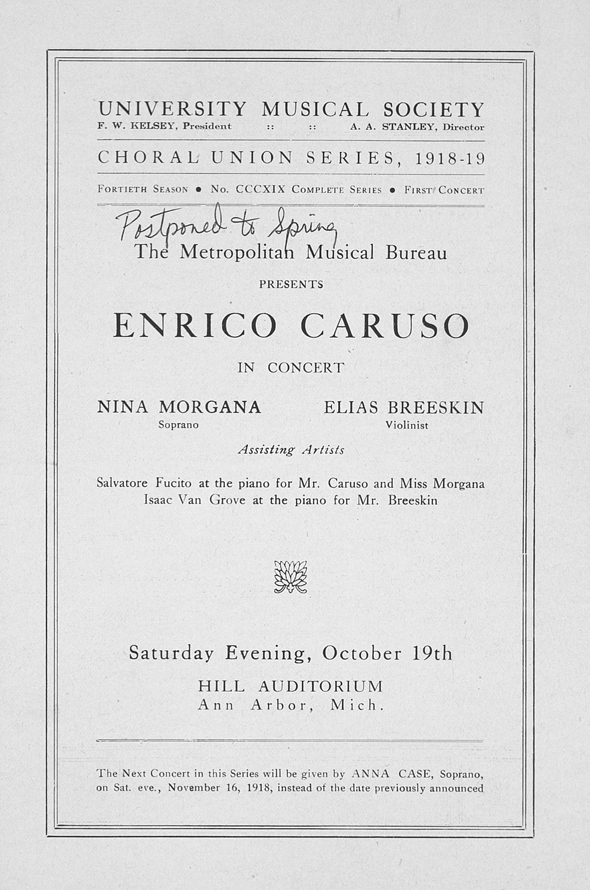
Photo: (Left) Enrico Caruso with his piano. (Right) UMS concert program.
Near the end of his 25-year career, Italian tenor Enrico Caruso was scheduled to sing selections from several operas during his performance alongside soprano Nina Morgana and violinist Elias Breeskin at Hill Auditorium in October of 1918. The performance was postponed until March of the following year due to the Spanish Flu pandemic.
The first singer to sell over a million copies of his recording, Caruso charmed audiences the world over as the first global media celebrity due to innovations in radio and television technology. His performance at UMS included an extensive repertoire of ten songs, all noted for their difficulty and beauty, including Souvenir de Moscow, Celste Aida, Una Furtiva Lagrima, Vesti La Giubba, and concluding with The Star Spangled Banner.
UMS Night School: 100 Years of UMS at Hill
Photo: Hill Auditorium’s first audience, May 14, 1913.
This year, UMS Night School focuses on 100 years of UMS at Hill Auditorium and illuminates the special history behind the great performers and performances that have shaped our community. These 90-minute “classes” combine conversation, interactive exercises, and “lectures” with genre experts to draw you into the themes behind each performance. Professor Mark Clague joins us again as host and resident scholar.
Session 8: Going Greek: Milhaud’s Oresteia of Aeschylus and 100 Years of UMS/School of Music Collaborations
Ralph Williams, Professor Emeritus of English at the University of Michigan, gave a lecture on the Oresteia of Aeschylus prior to a UMS Choral Union rehearsal. The UMS Choral Union performs as part of Darius Milhaud’s Oresteia of Aeschylus on April 4.
Also, we interviewed composer William Bolcom, who studied with Darius Milhaud, Kenneth Kiesler, conductor, Jerry Blackstone, chorus master, and Joseph Gramley, co-director of percussion.
Session 6: Sing Out: Soloists at Hill
Richard LeSueur’s picks for Great Soloists: First Half of 20th Century
Enrico Caruso
Jasha Heifetz
Vladimir Horowitz
Sergei Rachmaninoff
Richard LeSueur’s picks for Great Soloists: Second Half of 20th Century
Joan Sutherland
Itzak Perlman
Jessye Norman
Yo-Yo Ma
From the Hill Auditorium Celebration
Complete “Saturday Morning Physics” lecture on Hill Auditorium Acoustics
Session 4: Jazz in the Hall
Night School speaker Mark Stryker’s “Detroit drummer Karriem Riggins makes his mark in jazz, hip-hop” in the Detroit Free Press.
From UMS Lobby, the Detroit Sound Conservancy shares their top 5 picks for must-see Detroit music locations. Karriem Riggins tells us what he’s been listening to lately.
Session 3: HILL-ELUJAH! The Messiah and UMS Traditions at Hill
Resources provided by UMS archivist Richard LeSueur.
A few memorable Hallelujah chorus performances:
Sir Thomas Beecham (re-orchestrated):
Mormon Tabernacle Choir (large chorus):
Trevor Pinnock (small chorus):
Richard LeSueur’s recommended complete recordings of Messiah:
- Trevor Pinnock-Archiv 423 630-2 (superb soloists; wonderful sense of baroque style)
- Charles Mackerras-EMI 69449 (wonderful, small scale performance)
- Colin Davis-Philips 438 356-2 (slightly larger group, excellent soloists)
- Neville Marriner-Decca 444 824-2 (excellent performance)
- Andrew Davis-EMI 17645 (famous soloists)
- Thomas Beecham-RCA 61266 (re-orchestrated; very large chorus and orchestra)
- elmuth Rilling-Hänssler Classics 98434 (Mozart orchestration, sung in German)
And, check out this lovely preview and history of the Messiah on AnnArbor.com
Session 2: Riot! 100 Years of Stravinsky’s The Rite of Spring
Related Material:
Joffrey Ballet’s Reconstruction of the original Nijinksy Rite of Spring
- University of North Carolina – Chapel Hill’s “The Rite of Spring at 100” project website.
- “Stravinksy the Global Dance” web databaseof all known versions of “Rite”
- Film mentioned by Christian Matjias-Mecca, “Stravinsky: Once at a Border”
- Stravinksy Bibliography provided by Jeff Lyman and Beth Genne(of the U-M School of Music, Theatre & Dance).
- Igor Stravinsky: Le Sacre du Printemps Dossier de Presse/Press-Book.Collected by François Lesure. Editions Minkoff, Geneva, 1980: A collection of newspaper clippings, reviews, etc., in several languages, all of which address the first performances of The Rite of Spring in Paris, London, and in many other cities around the world. This is a true “first hand” guide for those of you interested in how the work was received initially.
- A Stravinsky Scrapbook 1940-1971. Robert Craft. Thames and Hudson, 1983 and Igor and Vera Stravinsky: A Photograph Album 1921-1971. Robert Craft. Thames and Hudson, 1982.Both of these books were assembled and annotated by Stravinsky’s assistant Robert Craft. While they may look like “coffee table books” at first, they are full of gems of information on a number of fronts, and I’ve looked to these for the many hidden facts and leads that I alluded to the other evening. You can read about the kind of life that Stravinsky led as a celebrity as well as a composer, and you can find plenty of timely information about his compositions after the “Big 3 Ballets,” his conducting engagements around the world, his recordings, and about his very busy life simply being Stravinsky.
- Stravinsky: The Composer and His Works. Eric Walter White.University of California Press, 1984. This is the most complete general reference work on all of Stravinsky’s compositions. In it you’ll find information on the date and circumstances of each work, the instrumentation, a brief description, some performance and recording history, etc. It may lead you to more works by the composer that you’ve not yet had a chance to encounter.
- Proof Through the Night: Music and the Great War. Glenn Watkins. University of California Press, 2003.
Many of you know our Professor Emeritus of Music Glenn Watkins, who you may recall was a good personal friend of Stravinsky. (Stravinsky in fact wrote the foreword to Watkins’ first book on the composer Gesualdo.) This book includes interesting chapters on Stravinsky’s work during the period of World War I, and how the circumstances of the war affected his music in style, in orchestration, in subject matter and more. In addition, the chapter on Ravel and especially the discussion of Ravel’s Concerto for the Left Hand will have you rushing to your cd players to hear the work again. - For all of the composer’s recordings of his own music, search the terms “Stravinsky conducts Stravinsky” and “Sony Classical.”Sony Classical took over Columbia Records, and Columbia was the company with which Stravinsky was contracted to make many of his recordings. They are all available on CD and via digital downloads.
- Stravinsky’s assistant Robert Craft began a series of recordings in the early 1990s with the plan to re-record all of Stravinsky’s works, from the most famous to the most obscure, and in every version of those that had been revised by the composer. I’m not sure he has finished it yet, and it has gone through a series of companies, some of which are no longer in business. Many of them are available on the Naxos label, others on MusicMasters, still others on Koch.
Other materials of interest:
- Stephanie Jordan, Moving Music, London: Dance Books (chap on Balanchine)
- Stephanie Jordan, Stravinsky Dances, London: Dance Books, 2011)
- Charles Joseph: Stravinsky and Balanchine, New Haven: Yale University Press (2002; paperback 2011)
- Charles Joseph: Stravinsky’s Ballets, New Haven: Yale University Press, 2011 or 12
- The Dance Element in Strawinsky’s Music.’ In ‘Strawinsky in the Theatre: A Symposium,’ edited by Minna
- Lederman. Dance Index 6:10, 11, 12 (October-December 1947), 250-56. Reprinted in Stravinsky in the
- Theatre, edited by Minna Lederman. New York: Pellegrini & Cudahy, 1949, pp. 75-84.
- George Balanchine: “The Dance Element in Music in Lederman, Minnie
Session 1: Iconic Hill: Culture, Community, and the Concert Hall
Related Material:
- Professor Mark Clague’s Article from The Opera Quarterly: The Industrial Evolution of the Arts: Chicago’s Auditorium Building (1889–) as Cultural Machine
- Info Sheet on the early history of Hill Auditorium and UMS (created by Charles Reischl)
- AADL’s UMS Archive
Share Your Hill Auditorium Memories
We’re celebrating Hill Auditorium’s 100th birthday during this 2012-2013 season, and we want to know about your experiences in Hill!
Check out our gallery of select “In Hill Auditorium, I am…” submissions below. We’ll grow it throughout our 2012-2013 season.
Download a flyer and submit your own Hill Auditorium Experience.
Featured memory, collected at the Mariinsky Orchestra performance on October 27, 2012:
“I used to sit up here in the 2nd balcony when a student at U-M (1953-56). This time, I was startled all over again by the clarity and distinctness of the separate instruments. Magical acoustics!
My father told me, years ago, that it was a picture of the just-built Hill Auditorium that inspired him to yearn for higher education. One of ten children on a farm near Fremont, he had never traveled further than a horse and wagon could go. He had never seen a remarkable building. In his memoirs he wrote, more than 60 years later, “I leafed through a “Michiganesian” in the school library and was captivated by a photo of Hill Auditorium, so majestic, so academic. Desire for college sprouted anew.”
After crops were planted in the summer of his senior year, he was released by his father to earn money as a laborer in Grand Rapids. That fall he had saved enough to enroll as a freshman at Calvin College.
In 1925, he and his new bride (my mother) came to Ann Arbor for graduate study. Two years later he was offered a job as instructor in the U-M Rhetoric Department, later absorbed into the English Department where he taught until he retired. Many many times they entered the great doors of Hill Auditorium and sat under the soaring bands of lights, and then in darkness heard the music.
His name was A. K. Stevens.”
Read the U-M memorial for A. K. Stevens. Notably, in 1944, A. K. Stevens was the faculty sponsor of the first University of Michigan Inter-Cooperative Council (ICC) co-op house, which was named in his honor, the A. K. Stevens Cooperative House.
Gallery of recent submissions:
PS. Yes, we love MoMA.
Maverick Mondays Series
This winter, University Musical Society (UMS) is presenting a 10-week, 10-event ‘renegade’ series focusing on thought-leaders and game-changers in the performing arts. San Francisco Symphony’s American Mavericks festival will close the series.
The second American Mavericks Festival, presented by SFS as part of its centennial season, will tour in its entirety to only two US venues: Hill Auditorium and Carnegie Hall.
We’ll be featuring multimedia content for the performances each Monday as part of our Maverick Mondays series.
A behind-the-scenes look at John Adams’ Infinite Jest:
Find out what Emerson, Thoreau, and Whitman sound like through Charles Ives’ Concord Symphony:
Conductor Michael Tilson Thomas and pianist Jeremy Denk discuss Henry Cowell’s piano concerto:
Composer Mason Bates talk about his new work, Mass Transmission:
San Francisco Symphony members and Michael Tilson Thomas remember the first American Mavericks Festival:
Conductor Michael Tilson Thomas talks about the meaning of “maverick”:
Learn about the American Mavericks All-Access Pass!
RSC Creative Residency in Ann Arbor
Photo: On stage during the RSC residency in March, 2001. More of our photos with the RSC here.
Next week, the Royal Shakespeare Company will visit Ann Arbor for its 2012 creative residency (March 10-20, 2012).
During three previous residencies presented by UMS, the RSC performed four history plays (“Henry VI, parts i, ii, and iii” and “Richard III” in 2001), a world premiere stage adaptation of Salman Rushdie’s “Midnight’s Children,” (alongside Shakespeare’s “Coriolanus” and “The Merry Wives of Windsor,” 2003) and “Antony and Cleopatra” and “The Tempest” starring Patrick Stewart (alongside “Julius Caesar” in 2006).
This residency, similar to one in 2010 which led to the production of three new plays, is a working residency and a collaboration with U-M, during which a creative team of six actors, two directors, voice and movement coaches, and the RSC’s dramaturg join actors from the New York-based LAByrinth Theater Company to focus on the development of two plays it hopes to produce during upcoming seasons: Pushkin’s “Boris Godunov” (directed by RSC artistic director Michael Boyd) and “The Orphan of Zhao,” the first Chinese play produced in Europe (directed by chief associate director Gregory Doran).
Creative Residency 2012 Public Events
Admission is free, though seating may be limited.
Tuesday, March 13, 5 pm
James Fenton Reading
Kalamazoo Room at the Michigan League
Friday, March 16, 4 pm
“The Orphan of Zhao” Presentation
Blau Auditorium, Ross School of Business
Saturday, March 17
9 am — “Word and Action: An Acting Master Class” with Gregory Doran
4 pm — “Bringing ‘Creative Project 2012’ to the Stage: The Audience and the Director” featuring Gregory Doran, RSC Chief Associate Director
Blau Auditorium, Ross School of Business
Sunday, March 18, 4 pm
“Drama in Translation” (a roundtable discussion) and “A Conversation with Michael Boyd, RSC Artistic Director, and Ralph Williams”
Blau Auditorium, Ross School of Business
Monday, March 19, 4:30 pm
Reading of “Boris Godunov”
Blau Auditorium, Ross School of Business
Have you attended RSC events in the past? Share your experiences below.
Robert Wilson: Video 50
Robert Wilson fans will have much to do in Ann Arbor this winter.
UMS is presenting preview performances of Einstein on the Beach, an opera by Robert Wilson and Philip Glass, January 20-22. Absolute Wilson, a film which chronicles the epic life, times, and creative genius of theater director Robert Wilson, will be screened on January 9. The film screening is free.
Photo: Robert Wilson. “Video 50,” 1978. Courtesy Electronic Arts Intermix (EAI), New York
In conjunction, UMMA’s Video 50 curates Robert Wilson’s “smaller-scale” experiments in video. Guest Curator Ruth Keffer describes the exhibit:
Video 50 consists of a randomly arranged set of 30-second “episodes”; counting occasional repeats and alternate versions, the 50 pieces of the title number nearly 100. Some of these episodes are static to the point of resembling still-lifes; others are self-contained vignettes that begin and end—or seem to end; any narrative resolution is teasingly withheld. With its use of early video techniques and the highly stylized, fashion-world look of its actors, Video 50 seems dated, but the way in which Wilson wields his domestic-gothic vocabulary is classic surrealism: everyday objects and settings made mysterious or comical or alien by their bizarre juxtaposition to one another, and by an equally nonsensical and cheerfully manipulative score of music and sound effects.
Read the full article in UMMA Magazine.
[VIDEO] Messiah Memories Bloopers
UMS first presented Handel’s Messiah in December of 1879. Over several weeks, we released a series of Messiah Memories webisodes from everyone involved over the years. We couldn’t resist releasing these staff bloopers.
Previously:
Episode 1: Jerry Blackstone, long-time Messiah conductor, forgets his jacket on the day of the performance.
Episode 2: Father Timothy Dombrowski, choral union member for over forty years, remembers “The Bat out of Hill.”
Episode 3: Megan Sajewski, resident of Martha Cook dormitory, talks about co-chairing the annual Martha Cook Messiah Dinner.
Episode 4: Meg Bragle (mezzo-soprano) and Mary Wilson (soprano), Messiah soloists and good friends, talk about the fun of coming back to Ann Arbor to perform in Messiah.
Q&A with Stile Antico
When UMS presented Stile Antico two years ago, it was one of the most talked-about events of the season. Stile Antico today is firmly established as one of the most original and exciting new groups in the choral music world. We asked the group a few questions.
1. Stile Antico work together without a conductor. What effect do you think working without a conductor has on the music you produce?
When we founded Stile Antico, we set out to explore the wonderful repertoire of the Renaissance in a new way. Instead of turning up to rehearsals and being told what to do, we wanted to work as chamber musicians – like a string quartet – deciding amongst ourselves how the music should be shaped and performed.
This approach throws a huge responsibility onto the individual singers. In a sense, we are all conductors: we need an extremely high level of collective listening to make sure that we always sing with good blend and ensemble. We also have to feel and react to the overall sound that we are making, at the same time as singing our individual lines. In our early years we sometimes rehearsed with our eyes closed, or facing away from one another, to hone our aural skills!
It also means that each singer has the opportunity to contribute creatively to our performances: we decide everything, from tempo and mood to dynamics and articulation, by discussion and experimentation. This means that we rehearse far more than other groups of our type – perhaps three or four times as much! – but, most importantly, that our interpretations ‘belong’ to the individual singers in a unique way, and (we hope!) that our performances are warmed from the inside, since the ideas that underlie them come from the group itself, rather than a conductor at the front. We can be spontaneous and fluid in performance, responding to one another as the mood takes us, and we find it an enormously rewarding way to work.
2. How do you put together a program in this kind of conductor-less collaborative environment?
As well as sharing in the musical decision-making, everyone in the group has individual roles – looking after our finances, website, travel and so on. There are five members of the group who take a particular lead on musical programming, working intensively on developing themes for future concerts and recordings. But everyone contributes to the discussion – our private website even has a ‘wish-list’ where we can all make repertoire suggestions. We generally have three or four programmes on the go at any one time, and work about two years ahead.
3. It’s often noted that Stile Antico is a group of /young/ singers. Do you have any advice for other aspiring young singers?
According to one of our basses, be a high tenor – they’re always in demand! But more seriously: have plenty of voice lessons. However natural your voice, it’s easy to fall into bad habits, and it’s great to have someone keeping an eye on you as you develop. If you’re considering becoming an ensemble singer, then get as much experience as possible, practice your sight-singing, and listen as widely as you can – the better you understand a particular style, the better you’ll sing it. But most importantly: always remember why you want to be a singer – it’s because you love the music!
4. In the spirit of the approaching holiday season, what is your favourite piece of holiday music to sing together?
In the spirit of collaboration, we discussed this at some length. The most popular option was Tallis’ Videte Miraculum, the ethereal responsory which opens our Puer natus est programme. But one tenor insisted that we record his preference for (his own arrangement of) Frosty the Snowman.
5.What are you looking forward to in your second visit to Ann Arbor?
A friendly and knowledgeable audience – and a return visit to Vinology!
Stile Antico perform at St. Andrew’s Episcopal Church on Wednesday, Dec. 7th.
[VIDEO] Messiah Memories: Megan Sajewski, resident of Martha Cook dormitory
UMS first presented Handel’s Messiah in December of 1879. In this third episode, Megan Sajewski, resident of Martha Cook dormitory, talks about co-chairing the annual Martha Cook Messiah Dinner.
Comment below with your own Messiah Memories!
Previously:
Episode 1: Jerry Blackstone, long-time Messiah conductor, forgets his jacket on the day of the performance.
Episode 2: Father Timothy Dombrowski and “The Bat out of Hill”
[VIDEO] A Q&A with Audra McDonald and U-M Musical Theatre Students
UMS presented Audra McDonald at Hill Auditorium on Nov 4 as part of the 11/12 season. Prior to the performance, Audra met with U-M Musical Theatre students for a Q&A session.
A transcript of the Q&A session is here.
[VIDEO] Messiah Memories: Father Timothy Dombrowski and “The Bat out of Hill”
UMS first presented Handel’s Messiah in December of 1879. In this second webisode of our Messiah Memories series, Father Timothy Dombrowski, choral union member for over forty years, remembers “The Bat out of Hill.”
Comment below with your own Messiah Memories!
Previously: Episode 1: Jerry Blackstone, long-time Messiah conductor, forgets his jacket on the day of the performance.



